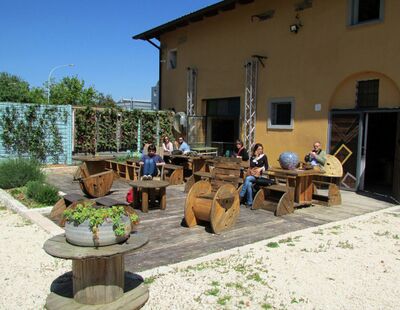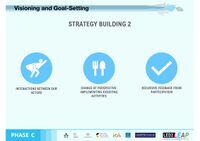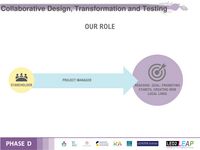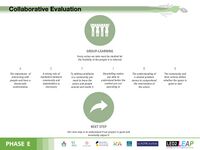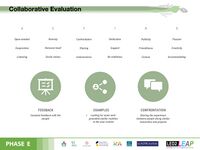LED2LEAP 2020 - Bologna Team 2
>>>back to working groups overview
Landscape Democracy Rationale
The community context is relevant for Etabeta because the main goal is social integration, for this reason community it's the core part of this integration process. Community inside EtaBeta created from a blank space an useful location to build new community and economical and social relationship.
Location and scope
Phase A: Mapping your Community
Places
There are two locations, one in the Villaggio del Fanciullo, in Scipione del Ferro street, near the railway station the other is called Spazio Battirame. The Villaggio del Fanciullo is called in this way because different social realities live there, a kind of smart village built in the 20s that from a convent has become a place where different social realities and other cooperatives meet. In this once-religious space different legal entities share the location and have a common background. There was an initial division between the people that were sent to share a space and had apparently nothing in common. But through out time, a symbiotic mechanism is activated, allowing the actors to cooperate and live together in the shared space. Instead Spazio Battirame initially was a colonic house from the nineteenth century, owned (ound) by one of the most important family in Bologna at the time. A strip of land is still connected to this space, revealing the Roman geometric scanning of the fields still present today. This colonic house still has a stable and a barn; in the 70s it was abandoned and lost its historic value. In the 90s a social center was moved in the area; more over, a tensile structure, initially built for Italia 90 Worldcup was reused there and divided into two parts. The association that stayed there, Livello 57, usually was a source of public disorder, organizing concerts and various events. At the end of 2007 there was a gas explosion causing victims; and for this reason everything was closed. The place, left to itself, became a place of abusive activities, until the arrival of Eta Beta In 2014; their presence lead to the transformation of this land from the industrial area of Bologna into an agricultural area, with teaching rooms and a restaurant that opened soon after their presence began to be noticed.
Socio-economic characteristics
The cooperative is a mixed type cooperative, being at the same time type A and type B. These cooperatives in general have a difference in their balance sheets and financial reports and in how they are viewed by the central government. The type B cooperative mainly deals with production work with disadvantaged groups that can be various, but in particular it deals with the sector of psychiatry, addictions and social problems.
The community is thought as an enclosed circle that three pillars sustain:
- The man, intended both as citizen and as monk, in the greek meaning of the word, “monakos”, that stands for a lonely part in his relationship to the others;
- Wellness and community, as individual well-being, and as collective community health;
- Creativity, because the well-being in a community is made possible by making unique things with benefits on the community itself.
Groups of actors and stakeholders in your community
The cooperative works with the following disadvantaged groups:
- people with addictions;
- people with psychiatric needs;
- unaccompained minor;
- Prisoners;
- Foreigners;
- Refugees.
The various branches of Etabeta Cooperative exist thanks to the collaboration with some external agencies you can see on the diagram picture. The most important one is the AUSL in Bologna. Usually type-A workers are tutors for the activities the type-B workers do.
Spazio Battirame Activities ad Places
- Tensile strcuture and workshop:
- Glassmaker workshop;
- Ceramic workshop;
- Woodworking workshop.
- Orchards and gardens:
- Different kind of terrains with various functions;
- Inside courtyards;
- Orchards;
- Cycle-garden corridory.
- House and cooking:
- Kitchen;
- Cafè;
- Barn;
- Cooking school.
Relationships between your actors and groups
This is a short list of the cooperative activies, they all follow the ideals of the cooperative: social functions, well-being, sustainability and education and collective culture.
- Laundry: born in 2009, a service of washing and rental of diapers dedicated to private and public kindergardens in Bologna. This activity was never done before in Italy and its impact is remarkable.
- EtabetaBio: agriculture activity born since 2019, autonomous thanks to the four hectares of terrain given in concession to the cooperative from S. Donato and S. Vitale districts.
- Alfa-Beta: activity of cleaning in external places and specific things, like ambulances, condos, ambulatories.
- Workshops: glassmaker, ceramic, mosaic and woodworking workshops made for socio-rehab purposes in the tensile structure of spazio Battirame.
- Seminars, meetings, traning courses of various kind.
- Post-school activities in Villagio del fanciullo.
The different branches of the cooperatives are not independent but they collaborate one with another. In Spazio Battirame they achive to create a fertile dialogue between them: the raw materials of the kitchen comes from the orchards nearby, and it’s served during the activities for the cooking schools. Part of the vegetables is sold in the Novale market to the local population. The workshops make the dishes used in the kitchens and they also distribute them to high-level restaurants thanks to the partnership with the local company “Servito”.
Summary of your learnings from the transnational discussion panel on April 22
The main difference between Bologna case study and the others is mainly the scale of the location. While Eta Beta's community works within the spacial range of a neighborhood, the other group were given a location much more bigger. This of course change the methods of research needed to explore such communities, that we have shared in the presentation
Reflection
Our locations are a great example of how pre – existing physical space can take on different connotations during its life based on usuale habits of the visitors , while remaining the same space. The locations are in fact witnesses of how the passing of time, coupled with the change of the populations inhabiting the space can shape the landscape itself, proving the human nature of this element (the landscape). There are not negative or positive spaces, they are all neutral. The community and the actions they made are indeed the ones which define whether the space is good or bad.
Problems
As designer we should investigate which kind o society we are building next. Nowadays however the necessary discussion to study the landescape, a human perception, is particulary difficult. We hope we can still tackle wicked problem even with the limited mens we have in isolation. As It’s no secret that seeing things with your own eyes results in better perceptions, but for this time, better be safe and stay at home.
Phase B: Democratic Landscape Analysis and Assessment
The Scene in your Story of Analysis
Today we are going to talk about the cooperative named Eta Beta. The main goal of Eta Beta is to re-introduce people who have encountered difficulties in the past into the job market. We are talking about people with addictions, former prisoners, migrants or other socially disadvantaged people.The real aim of eta beta is not only this. In fact, the cooperative obviously want to reintroduce these people into the workplace but wanted to do so without these people continuing to feel stigmatized or rejected because of their past ; so to sum up we are talking about a reintegration into society in an equal way.
From the economic point of view Eta Beta is a mixed type cooperative, which means that they must have at least 3 workers with a disability percentage of at least 40%. In this way, Eta Beta not only helps the people involved within the group, but also indirectly benefits the public sector. It should be noted that otherwise these people would end up inside the prison circuit or structures specifically used for mental disorders.
As we sow the last time The cooperative is located in Bologna, precisaly it has its headquarters in the Battirame area, which we had already mentioned and introduced last time. Not only does the cooperative operate in the Bologna area, but also through a dense network of contacts called the '30km network'. Eta beta manages to operate in larger areas of the territory. The ‘30 km network’ is a typical medieval exchange network based on the interconnection of different networks on a human level; it’s evident that by linking the individual networks I can obtain a network at 60 km, 90 km, and so on that’s the strngeth of Eta beta.
The Actors in your Story of Analysis
Let’s introduce The actors:
- The main characters of our story is Juan, he is the founder of Eta Beta, he was born in Catalonia, and moved to Italy where he is currently living. He is mainly an artist. In the course of his life, he has understood his desire to contribute by creating something that could really be useful for the society. From this awereness he came up the first experiments of an associacion with would eventually become the Eta Beta cooperative.
- Another notable figure is his wife Giovanna, she is graduated in philosophy, with her the idea of the association took shape at the very begginnig .
- Then naturally, there are all the people who work with Eta Beta, both those inside and outside the cooperative and obvioulsy The clients
The Story of Analysis
First chapter: The Beginning
he background of the story is placed in the 80’s, a time when a social issue more than other became relevant to the eyes of the protagonist. Drug abuse was spreading into society from below, attacking the weakest and leaving them even weaker. The person dealing with addiction suffered not only the physical consequences, but also experienced the stigma connected with drug addiction. In this frame moved the protagonist, who decided to give his best shot trying to fix this problem. The community that started from there was young and centered on art and crafts: a lot of artists would pass by and give their opinion, share their knowledge, giving a big effort in building that piece of community that was trying to make people comfortable about themselves and about their problems.
Second Chapter: The Growth
The community starts to grow, in term of relations as well as number of people involved. Every day there is more and more knowledge involved, and the community decides to challenge itself diversifying its activities. This decision leads to a collection of activities in which the cooperative starts to bloom: one of this is the agricultural field, trying to develop a system for selling the food they grew.
Third Chapter: The Market
The activity becomes stable and their first fruit is delivered. The net developed before now is used to its maximum when the sell-planning is made. Opening themselves to a market is still a leap too big for the community, but the work on the fields aims to increase the production and diversify the food they brought to the table. In the last decade, the growth of the agricultural sector of the community is enough to let them take the big leap of a bigger open market. Now the community finds itself in the constellation of association that grow and sell their food in a market, a place that allows not only economic exchange, but also the connection between people. The workers of the community now can talk to people to sell their food, and this allow a whole new level of enrichment and skill learning, which is a huge boost for their personal recovery path.
Reflect on your Story of Analysis
It was fundamental for the research team to keep an open mind trying to discover all the different faces of the community, being the community itself a wicked problem. The perception of the work shifted from an everyday duty to a recovery path that can be use by everybody, paired with a perception of community and its sense of belonging. The community holds solid roots that guide them through all their objectives, without prescribing specific paths, but keeping an open future of possibilities for the entire association.
Phase C: Collaborative Visioning and Goal Setting
The Scene in your Story of Visioning
Our journey starts with the recognition of our challenge: living the city under this condition. The pandemic we are undergoing has radically changed the perspective of social interactions. We are ready to face this new condition, that will inevitably shape the social environment of the city. One important fact to understand is that the city needs to be lived by all its components, and the current laws enforcements push us to redefine the spaces in which our actors play.
The Actors in your Story of Visioning
Our actors involved are all inhabitants of the city.
- The students, as one of the most dynamic generation that lives the city: is important for to involve the students, from the one hand, because we too are students, and the other hand, because we know how crucial is to have a fresh input on every activity involving the city.
- The workers of eta beta: they are the backbones of the institution, the players that contribute the most to the health of the cooperative.
- The institutions of the city: because it is fundamental to know the counterpart to talk to. A good relationship with the institution is the key to a fruitful work
- Cultural institutions: there are already many city realities that deals with the city tissues and that knows how to distribute their contents; It is a good strategy to refer to them when approaching our city communities.
The Story of Visioning
So our goal is to better connect the cooperative to the social tissue of the city. That because we’ve found that the cooperative could benefit from a larger group on users. That could be accomplished in a variety of ways. Our Slogan is Pick Nic You Up, as a way to say that we wish to connect the cooperative with the community by implementing the way they sell their products. Today that the rules of mass events are changing, its useful to think about other ways to distribute what Eta Beta produces.
- It's necessary a good coverage of the social media platforms, as a virtual place in which to present itself as a community in the community.
- It's clear that the effects of the SARS CoV-2 are here to stay for some time, so its reasonable to plan according to the laws that they’ve produced.
- Finally, it's vital to connect the younger parts of the city to the cooperative, to assure not only a growth of the community itself, but also to facilitate a fresher income of ideas and an inclusive dialogue between parts.
Strategy building
To assure that the rules of the city in terms of disease prevention are matched, we can diversify the type of activities that were already practiced before; one of the most important, as discussed last time, was the open market, in which the workers of Eta Beta were capable of confronting themselves with customers. That part, as said, was crucial for the development and recovery of a person, because the interaction between the entire work of the community and the “outside world” of the city society is what normalize people who had previous issues with society on various levels. So we thought about maintaining that dimension, so important for the cooperative, but changing the perspective; instead of the open market, the regulations force the sellers towards a more product-to-individual approach, and its important to match this strategy with the target that we though before. To live the city in a meaningful way, its possible to offer the same products but in a more individual approach, such as a presence in the big parks of the city, in which the presence of people is now allowed by the local regulations; selling their food in a fast-food kind of way is likely to produce a different effect on the customers, but still is a good way to network with much more age groups. The feedback is recursive and can be checked day by day; if the social media machine works parallel to this kind of distribution, the target of people that comes across should be much more broad and the indicator of the success is the community itself, that will enriches with new generations and ideas.
Reflect on your Story of Visioning
It’s important to learn from failures along the way, so that they can be interpreted and integrated in the process of making. Also, to have an open mind means to have a good understanding of how the parts and the actors works by themselves and between themselves, as a interrelation of parts.
Phase D: Collaborative Design, Transformation and Planning
Introduction and Prototyping Action
Our main goal it’s to create social gatherings to promote EtaBeta activities inside Bologna. This main goal will be realized creating a “Pic Nic service” inside Bologna’s green areas, where Etabeta will preare meal for partecipant and promote and organize opportunities to enjoy this kind of service. The idea was born to promote and share Etabeta’s activies into new customer that never heard before. We think that creating new meeting place and social event placed outside could be useful to deal with Post Covid problem becasue during our studyng phase we notice how this place can became an opportunities for sharing knowledge with different people as we already seen in Mercato del Novale organized by Etabeta.
The Evolution of Your Prototyping Action
The main actor of this new project are Etabeta’s volunteers and employers that will organized the event and prepare meals cooked inside Zona Battirame using the products picked inside the same area. Obviuosly the city of Bologna will have the duty to allow the activities. But the most important actors are the younglings that become the customer of this new service. The project evolves from our experience with Etabeta that will gave to us the possibility to understand new way to develop the association.
As we already told the idea was born watching pre-existing activities of the cooperative. Joan, the founder of Etabeta told that his biggest wish is to engage young people into the cooperative, so we decided to promote the activity throught an event that can reach people. To understand if the idea could be succesful we shared a “Google Survey” between students. The results confirmed our ideas.
The Plan and the Realization of Prototyping Action
In this project are involved different subjects:
- Bologna’s Municipality has to allow our event.
- Etabeta as main actor: providing food and event manager.
- Bologna University as technical partner.Etabeta and the University of Bologna are already partner, our idea it’s to improve this partnership creating a contest for student to design the launchbox, and use this event as a experiment used as a study case of urban regeneration.
- Bologna’s citizen as customer.
The phases to realized the event are:
- First one: Asking permits for the event.
- Second one: Finding local stakeholder to provide more products and improve Eta Beta Network.
- Third one: Collaborating between University and Etabet lead to create packaging and visual identity. This kind of collaboration could be useful to spread event trought students.
- Fourth one: Collecting feedbacks from events to understand what need to be improved and what is working throught direct feedback and by social media.
Our role inside the organization of this project is to coordinate the interest of the envolved stakeholders, to achieve the common goal: promoting etabeta activities and using this kind of event like an opportunity to create new local link between activties and common people. If events are succesfull our future vision of Etabeta will be realized.
Reflect on Your Prototyping Action
If events are succesfull our future vision of Etabeta will be realized. We think that this kind of event will envolve more people into its activities making Eta Beta more famous between Bologna's citizens. The succes of this activities will be measured through the number of people envolved on social media and analizing Etabeta’s income.
Phase E: Collaborative Evaluation and Future Agendas
Collaborative Evaluation and Landscape Democracy Reflection
The challenge that our group founds when started approaching our Living Lab was to build and reinforce a better comunication between our case study and its environment; this is been faced studying the environment itself and the community that we were working on. We also tried to entwine the challenge with some of the Sustainble Development Goals, such as the work goal, that endure a vision in which the operator and its work is central, or the health of the workers and the citizen of the environment. Moreover the living lab focused also on living the environment that was our common ground: both for the community and the cooperative. Last the idea that every step of a new project should be taken with the principles of sustainability in mind leading the action.
The Actors in your Collaborative Evaluation
As we see in the previous phases our stakeholders are EtaBeta and his workers involved in the cooperative’s activities, Cultural Institution of the city of Bologna like “The Cineteca”, The municipality of Bologna and the young people that live in the city. By working together these stakeholder can all earn something, Eta Beta can gain visibility, new relationship with customers or associations, for expand his network; Cultural Association can create new and interesting cultural events involving more people and maybe create more discussion and new way of living Bologna; The municipality would acquire new events to attract new tourist or create new investments or jobs, as well the possibility of creating new ways of confrontation with citizens Young people and all the citizens of Bologna could get new spaces, events and get closer to associations and be more involved in the future of the city.
Currently we are only a group of students looking for a way to expand the cooperative’s relations in Bologna, we hope that our ideas can help to obtain greater visibility and to establish even more collaborations with citizens and other associations. Our desire in the future is to be more active within the cooperative to bring our ideas to life.
Reflection of the Online Seminar
We are living a work-in-progress phase as of today, so we cannot still evaluate firmly if our current goals and objective will eventually be matched. As of today, we are pretty satisfied with the work done.
The challenge that coronavirus made us face were pretty tough. We never experienced working from home before, so we had the need to adujst. While the teamworking between us seems to have been proceding quite smoothly, the biggest challenge was the confrontation with the members of the cooperative. Of course we did some online seminar with them, but still lacked the day-by-day real-life confrontation that is the most important part in this kind of works.
We decided, also to answer this difficult situation, to adopt two different kinds of indicators to keep in touch with the satisfaction of the people: surveys and social-media monitoring. This kind of instrument are the best way to keep in touch with the situation.
We think that our solution of the “Pick-Nic you up” can be very useful for the members of the community, as it will help them having more confrontation with the people as already highlighted by their founder Joan.
Reflection of the Living Lab Process
The most important lesson we learnt it’s about group learning. During Living Lab we noticed that every action we take must be studied for the fruibility of the people it is referred.
We written one lesson learnt for each individual team member:
- For Andrea: The importance of interacting with people and have a democratic confrontation.
- For Chiara: The strong role of mediation between community and stakeholders is necessary.
- For Francesco: To address problems in a community you need to know the actors and people around and inside it.
- For Ilaria: Storytelling makes you able to understand better the context you are operating in.
- For Riccardo: The understanding of a wicked problem means to comprehend the interrelation of the actors.
- For Simone: The community and their actions define whether the space is good or bad.
Our next step is to understand if our project is good and eventually adjust and apply it because our Living Lab action was only theoretical and not practical, our hope it’s to convert this theoretical studies into concrete action.
Your Living Lab Code of Conduct
Last week we’ve done the mural exercise, we should think to some values or principles that were really important for us as person, and here they are, we could see that we have wrote a lot of differnt words but some of them are very similar in the meaning.
This three instead are some conclusion that we have made about the top ground rules that we’ll follow in the future for the Living Lab The first one is that feedback is very important, in one of our presentation during the LED course we made a ‘mistake’. We took for granted that the solution to a problem we came up with during the analysis was absolutely the best solution for the project. We thought we didn’t need to involve or ask others their opinion cause if six people came up with the same idea this was meaning something.
We realized we have been superficial so the next time we did a survey for testing if the idea was good or if it was only our belief. With the survey we have checked that it was a really good idea and not just for us. With the survey people also gave us some suggestion and that was great! So, we have learned that the feedback is a fundamental step even when we don’t consider it necessary
We found extremely useful also looking for some well-grounded similar realities in the near context, it was helpful for us trying to identify some similar realities to understand what was working and what was not.
Finally, we want to underline that also sharing the experience between people doing similar researches and projects is fundamental for us. Infact we have found extremely useful the seminar because we could see other people dealing with similar challenges and it gave us new ideas and we could also confront our work with the work of other and understand if something should be changed or improved or instead if something was working well and it was already good.
Process Reflection
The study we carried on Eta-Beta community made us better reflect on the problems and issues that a group of people and activity must face when they deal with the citizens, while offering various services. We had the opportunity to challenge the difficulties behind a reality with a solid variety of stakeholders, that are far beyond the usual field we are usually working on. The mental experiment of designing for a well-established reality on the territory, brought in the big challenge of studying the socio-economic tissue of the city of Bologna, to have well targeted solution for their problems. We also met, in doing these activities, the big challenge of the remote communication, which was particularly hard for the confrontation with our case-study community. It is indeed important to have a continue feedback to correct your own action. Furthermore, the team-working, made on online platforms, carried the bias of the distance, that would have been removed in the live meetings. One of the most important lessons we learnt is how to deal with different realities, that was made possible by the online platform. This modality made our horizon even wider, thanks to the different experiences that were weekly presented to us, from the simple exercises to the examples studied that showed us the various perspectives inside the heterogeneous group of work. Surely, when we will challenge a similar task in the future, we will have more attention in surveying and knowing the opinions of the actors involved, that in this particular moment were difficult to envision and observe.
